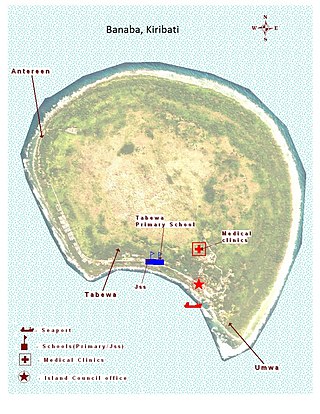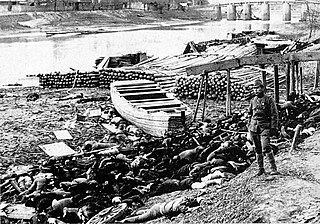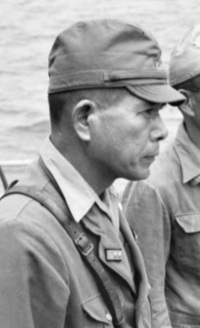Related Research Articles

The International Military Tribunal for the Far East (IMTFE), also known as the Tokyo Trial and the Tokyo War Crimes Tribunal, was a military trial convened on 29 April 1946 to try leaders of the Empire of Japan for their crimes against peace, conventional war crimes, and crimes against humanity, leading up to and during the Second World War. The IMTFE was modeled after the International Military Tribunal (IMT) at Nuremberg, Germany, which prosecuted the leaders of Nazi Germany for their war crimes, crimes against peace, and crimes against humanity.

Tomoyuki Yamashita was a Japanese convicted war criminal and general in the Imperial Japanese Army during World War II. Yamashita led Japanese forces during the invasion of Malaya and Battle of Singapore, with his accomplishment of conquering Malaya and Singapore in 70 days earning him the sobriquet "The Tiger of Malaya" and led to the British Prime Minister Winston Churchill calling the ignominious fall of Singapore to Japan the "worst disaster" and "largest capitulation" in British military history. Yamashita was assigned to defend the Philippines from the advancing Allied forces later in the war, and while unable to prevent the Allied advance, he was able to hold on to part of Luzon until after the formal Surrender of Japan in August 1945.

Banaba is an island of Kiribati in the Pacific Ocean. A solitary raised coral island west of the Gilbert Island Chain, it is the westernmost point of Kiribati, lying 185 miles (298 km) east of Nauru, which is also its nearest neighbour. It has an area of six square kilometres (2.3 sq mi), and the highest point on the island is also the highest point in Kiribati, at 81 metres (266 ft) in height. Along with Nauru and Makatea, it is one of the important elevated phosphate-rich islands of the Pacific.

Sook Ching was a mass killing that occurred from 18 February to 4 March 1942 in Singapore after it fell to the Japanese. It was a systematic purge and massacre of 'anti-Japanese' elements in Singapore, with the Singaporean Chinese particularly targeted by the Japanese military during the occupation. However, Japanese soldiers engaged in indiscriminate killing, and did not try to identify who was 'anti-Japanese.' Singapore was a crucial strategic point in World War II. From 8 February to 15 February, the Japanese fought for control of the city. The combined British and Commonwealth forces surrendered in a stunning defeat to the outnumbered Japanese on 15 February which led to its fall. The loss of Singapore was and still is Britain's largest surrender in history.

The Empire of Japan committed war crimes and crimes against humanity in many Asian-Pacific countries during the period of Japanese imperialism, primarily during the Second Sino-Japanese and Pacific Wars. These incidents have been described as "the Asian Holocaust". Some war crimes were committed by Japanese military personnel during the late 19th century, but most were committed during the first part of the Shōwa era, the name given to the reign of Emperor Hirohito.
The Micronesians or Micronesian peoples are various closely related ethnic groups native to Micronesia, a region of Oceania in the Pacific Ocean. They are a part of the Austronesian ethnolinguistic group, which has an Urheimat in Taiwan.

The Borneo campaign or Second Battle of Borneo was the last major Allied campaign in the South West Pacific Area during World War II to liberate Japanese-held British Borneo and Dutch Borneo. Designated collectively as Operation Oboe, a series of amphibious assaults between 1 May and 21 July 1945 were conducted by the Australian I Corps, under Lieutenant-General Leslie Morshead, against Imperial Japanese forces who had been occupying the island since late 1941 – early 1942. The main Japanese formation on the island was the Thirty-Seventh Army under Lieutenant-General Masao Baba, while the naval garrison was commanded by Vice-Admiral Michiaki Kamada. The Australian ground forces were supported by US and other Allied air and naval forces, with the US providing the bulk of the shipping and logistic support necessary to conduct the operation. The campaign was initially planned to involve six stages, but eventually landings were undertaken at four locations: Tarakan, Labuan, North Borneo and Balikpapan. Guerilla operations were also carried out by Dayak tribesmen and small numbers of Allied personnel in the interior of the island. While major combat operations were concluded by mid-July, localised fighting continued throughout Borneo until the end of the war in August. Initially intended to secure vital airfields and port facilities to support future operations, preparatory bombardment resulted in heavy damage to the island's infrastructure, including its oil production facilities. As a result, the strategic benefits the Allies gained from the campaign were negligible.

The Manila massacre, also called the Rape of Manila, involved atrocities committed against Filipino civilians in the City of Manila, the capital of the Philippines, by Japanese troops during the Battle of Manila which occurred during World War II. The total number of civilians who were killed by the Japanese as well as American artillery and firing is estimated to be at least 100,000.
Rabi is a volcanic island in northern Fiji. It is an outlier to Taveuni, in the Vanua Levu Group. It covers an area of 66.3 square kilometers, reaching a maximum altitude of 463 meters and has a shoreline of 46.2 kilometers. With a population of around 5,000, Rabi is home to the Banabans who are the indigenous landowners of Ocean Island; the indigenous Fijian community that formerly lived on Rabi was moved to Taveuni after the island was purchased by the British government. The original inhabitants still maintain their links to the island, and still use the Rabi name in national competitions.

Sir Albert Fuller Ellis was a prospector in the Pacific. He discovered phosphate deposits on the Pacific islands of Nauru and Banaba in 1900. He was the British Phosphate Commissioner for New Zealand from 1921 to 1951.
The British Phosphate Commissioners (BPC) was a board of Australian, British, and New Zealand representatives who managed extraction of phosphate from Christmas Island, Nauru, and Banaba from 1920 until 1981.
United States war crimes are violations of the law of war which were committed by members of the United States Armed Forces after the signing of the Hague Conventions of 1899 and 1907 and the signing of the Geneva Conventions. The United States prosecutes offenders through the War Crimes Act of 1996 as well as through articles in the Uniform Code of Military Justice. The United States signed the 1999 Rome Statute but it never ratified the treaty, taking the position that the International Criminal Court (ICC) lacks fundamental checks and balances. The American Service-Members' Protection Act of 2002 further limited US involvement with the ICC. The ICC was conceived as a body to try war crimes when states do not have effective or reliable processes to investigate for themselves. The United States says that it has investigated many of the accusations alleged by the ICC prosecutors as having occurred in Afghanistan, and thus does not accept ICC jurisdiction over its nationals.

Michiaki Kamada was a vice-admiral of the Imperial Japanese Navy who saw service in the Pacific Theatre of World War II.
The 33rd Brigade was a formation of the Australian Army established at the end of World War II. Formed in August 1945 at Morotai Island, it consisted of three Australian Imperial Force infantry battalions that were raised for occupation duties in the Dutch East Indies following Japan's surrender. After deployment to Timor and Ambon, it returned to Morotai when Dutch colonial rule was re-established. It was disbanded in early 1946 and its personnel demobilised.

The Japanese occupation of Nauru was the period of three years during which Nauru, a Pacific island which at that time was under Australian administration, was occupied by the Japanese military as part of its operations in the Pacific War during World War II. With the onset of the war, the islands that flanked Japan's South Seas possessions became of vital concern to Japanese Imperial General Headquarters, and in particular to the Imperial Navy, which was tasked with protecting Japan's outlying Pacific territories.
James Gowing Godwin was a pilot of the Royal New Zealand Air Force during the Second World War, who subsequently became a prisoner of war. After the end of the war, as a captain in the Australian Army, he became an investigator with the Second Australian War Crimes Section in Tokyo in July 1947 and developed the case against Lieutenant General Takuma Nishimura, the senior perpetrator of the Parit Sulong Massacre. He subsequently worked for the First Australian War Crimes Section, based in Singapore, then worked for the British colonial service. He died in Sydney at the age of 72.

Before the outbreak of World War II in the Pacific, the island of Borneo was divided into five territories. Four of the territories were in the north and under British control – Sarawak, Brunei, Labuan, an island, and British North Borneo; while the remainder, and bulk, of the island, was under the jurisdiction of the Dutch East Indies.

Henry Reid Bay is known locally as Homhovulu Harbor. It is a bay on the southerly coast of New Britain that opens into Wide Bay. It forms the furthest penetration of Wide Bay and is defined by Zungen Point on its north shore and Cape Turner on its southern shore. Wide Bay and Open Bay, on the northerly coast, form the isthmus separating the Gazelle Peninsula from the western part of the island.
The Philippine War Crimes Commission was a commission created in late 1945 by General Douglas MacArthur as Supreme Commander of the Allied Powers to investigate the war crimes committed by the Imperial Japanese Army and Imperial Japanese Navy during the invasion, occupation, and liberation of the Philippines. The investigation by the Commission led to the extradition, prosecution, and conviction of Class A, Class B, and Class C defendants in Manila, Tokyo, and other cities in East and Southeast Asia through the International Military Tribunal for the Far East.

The Japanese occupation of the Gilbert Islands was the period in the history of Kiribati between 1941 and 1945 when Imperial Japanese forces occupied the Gilbert Islands during World War II, in the Pacific War theatre.
References
Footnotes
- ↑ Macdonald 2001, p. 148.
- ↑ Pappas 1998, pp. 163–167.
- ↑ Macdonald 2001, p. 149.
- ↑ Field 2005, p. 72.
- ↑ Morris 2019.
- 1 2 Sissons 2020, p. 107.
- ↑ Morris 2019, p. 321.
- ↑ Morris 2019, p. 330.
- 1 2 Morris 2019, p. 337.
- ↑ Morris 2019, p. 340.
- 1 2 Morris 2019, p. 341.
- ↑ Morris 2019, p. 350.
- 1 2 Morris 2019, p. 364.
- ↑ Morris 2019, p. 365.
- ↑ Carrel 2005, p. 195.
- ↑ Morris 2019, p. 279.
- ↑ Morris 2019, p. 285.
- ↑ Morris 2019, p. 290.
- ↑ Morris 2019, p. 295.
- ↑ Morris 2019, p. 299.
- ↑ Morris 2019, p. 311.
- ↑ Morris 2019, p. 313.
- ↑ Morris 2019, p. 347.
- ↑ Morris 2019, p. 349.
- ↑ Morris 2019, p. 360.
- ↑ Morris 2019, p. 368.
- ↑ Morris 2019, p. 369.
Sources
- Carrel, Michael (2005). Australia's Prosecution of Japanese War Criminals: Stimuli and Constraints (PDF) (PhD). University of Melbourne. OCLC 224899522.
- Cushman, Gregory T. (2013). Guano and the Opening of the Pacific World: A Global Ecological History. Cambridge University Press. ISBN 978-1-107-31072-8. OCLC 1128417651.
- Dunne, Bridget; Durham, Helen (2016). "The Prosecution of Crimes against Civilians". In Fitzpatrick, Georgina; McCormack, Timothy L.H.; Morris, Narrelle (eds.). Australia's War Crimes Trials 1945-51. Leiden, The Netherlands: Brill Nijhoff. pp. 196–235. doi:10.1163/9789004292055_008. ISBN 9789004292055. OCLC 958044885.
- Ellis, Albert Fuller (1946). Mid-Pacific Outposts. Brown and Stewart Limited. OCLC 508320723.
- Field, Michael (2005). "Kabunare's story". In Shennan, Jennifer; Tekenimatang, Makin Corrie (eds.). One and a Half Pacific Islands: Stories the Banaban People Tell of Themselves. Wellington: Victoria University Press. pp. 71–74. ISBN 978-0-86473-523-2.
- "Japs Massacre Ocean Islanders After Surrender – Two Officers on Trial in Rabaul for Vile Crime". Pacific Islands Monthly. Sydney: Pacific Publications. XVI (10): 13. 16 May 1946. ISSN 0030-8722. nla.obj-330804362 – via Trove.
- Macdonald, Barrie (2001). Cinderellas of the Empire: Towards a History of Kiribati and Tuvalu. Suva, Fiji: Institute of Pacific Studies, University of the South Pacific. ISBN 982020335X. OCLC 494270319.
- Morris, Narrelle (2013). "Justice for 'Asian' Victims: The Australian War Crimes Trials of the Japanese, 1945–51". In Heller, Kevin; Simpson, Gerry (eds.). The Hidden Histories of War Crimes Trials. Oxford: Oxford University Press. pp. 348–366. doi:10.1093/acprof:oso/9780199671144.001.0001. ISBN 9780199671144.
- Morris, Narrelle (2019). Japanese war crimes in the Pacific: Australia's investigations and prosecutions (PDF). Kingston, ACT: National Archives of Australia. ISBN 978-1-922209-22-1.
- Pappas, Caroline (1998). Law and Politics: Australia's War Crimes Trials in the Pacific, 1943- 1961 (PhD). University of New South Wales. OCLC 222558875.
- Rottman, Gordon L. (2002). World War II Pacific Island Guide: A Geo-military Study. Greenwood Publishing Group. ISBN 978-0-313-31395-0. OCLC 475274605.
- Shennan, Jennifer; Tekenimatang, Makin Corrie (2005). One and a Half Pacific Islands: Stories the Banaban People Tell of Themselves. Victoria University Press. ISBN 978-0-86473-523-2.
- Sissons, David (2020). Tamura, Keiko; Stockwin, Arthur (eds.). Bridging Australia and Japan: Volume 2 the writings of David Sissons, historian and political scientist. Acton, A.C.T.: ANU Press. doi: 10.22459/BAJ.2020 . ISBN 9781760463762. OCLC 962408104. S2CID 225347954.
- Tanaka, Yuki (November 2010). "Japanese Atrocities on Nauru during the Pacific War: The murder of Australians, the massacre of lepers and the ethnocide of Nauruans". The Asia-Pacific Journal: Japan Focus. 8 (45). ISSN 1557-4660.
- Teaiwa, Katerina Martina (2015). Consuming Ocean Island: Stories of People and Phosphate from Banaba. Indiana University Press. ISBN 978-0-253-01460-3.